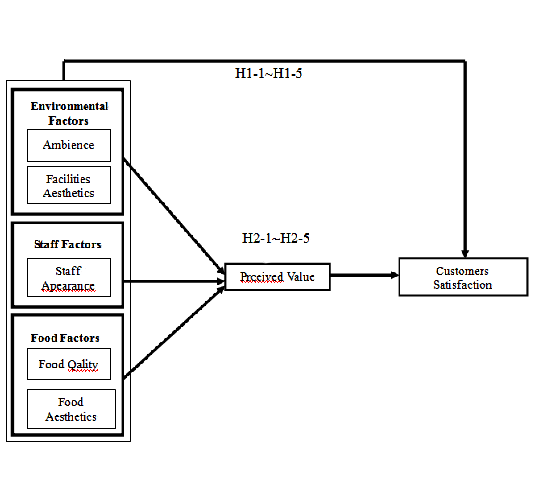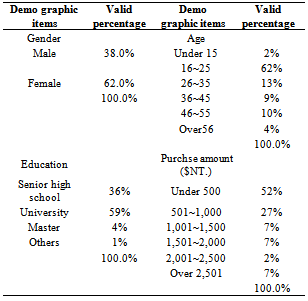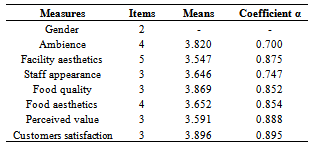-
Paper Information
- Next Paper
- Previous Paper
- Paper Submission
-
Journal Information
- About This Journal
- Editorial Board
- Current Issue
- Archive
- Author Guidelines
- Contact Us
American Journal of Economics
p-ISSN: 2166-4951 e-ISSN: 2166-496X
2013; 3(C): 108-113
doi:10.5923/c.economics.201301.18
An Experimental Investigation of Consumers’ Perceived Value and Dining Satisfaction
Hsueh Hsun Tu
Department of Industrial Engineering and Management Information, Huafan University, Taiwan
Correspondence to: Hsueh Hsun Tu, Department of Industrial Engineering and Management Information, Huafan University, Taiwan.
| Email: |  |
Copyright © 2012 Scientific & Academic Publishing. All Rights Reserved.
The article proposes a model that related the mediating role of perceived value in the reltionships among ambience, facilities aesthetics, staff appearance, food quality and food aesthetics and sumer's dining satisfaction. Data was collected from consumers who had dining experience in the most recent month.. A total of 400 questionnaires were distributed, of which 224 were successfully replied respondents, yielding a usable response rate of 56%. Multiple regression analyses were used for hypothesis testing. The results of this article show support the hypothesis that quality of food and the aesthetic presentation of food have a positive influence on perceived value. The results also show tht perceived value plays a mediating role in the relationship of food quality, food aesthetics and customers satisfaction. Our finding contributes new evidence to dispute views in previous studies, while at the same time offering important implications for both research and practice.as illustrated by the portions given in this document.
Keywords: Satisfaction, Perceived Value, Staff Appearance, Facilities Aesthetics, Food Quality
Cite this paper: Hsueh Hsun Tu, An Experimental Investigation of Consumers’ Perceived Value and Dining Satisfaction, American Journal of Economics, Vol. 3 No. C, 2013, pp. 108-113. doi: 10.5923/c.economics.201301.18.
Article Outline
1. Introduction
- The quality of life in modern times is quite high, so price and functionality can no longer satisfy the needs of consumers. Outside of their jobs, consumers spend money to improve their quality of life so that they are satisfied spiritually. In light of this trend, many physical stores or enterprises are using aesthetic elements to arouse consumers' desire to spend, and to satisfy the consumers' emotional needs. For example, the styles and color combinations in stores give consumers young, fashionable, and bright feelings. Space designs and commodity displays and arrangements emphasize both experience and product quality, to attract customer attention.Apart from aesthetics, another constant priority in the service industry is to let customers feel they are receiving good service quality. The attitude of service providers becomes the key to communicating services. In the food service industry, the quality of the served food will without a doubt be one of the important factors affecting customers' satisfaction and loyalty[1],[2],[3]. Staff’s appearances and interactions with customers sometimes also play an important role[4]. To confirm the influence of multiple simultaneous factors, this study divided aesthetics in three categories, involving the facilities, people, and food. On the other side of the coin are important physical factors such as the atmosphere and quality of food. The correlation among perceived value, the environment (ambience and facility aesthetics), people (appearance), food (quality and food aesthetics), and customer satisfaction was explored and empirical data analyzed, in order to find the major factors influencing the perceived value and satisfaction among consumers, and provide suggestions based on research results for the reference of academia and the outside world.
2. Literature
2.1. Satisfaction
- Parasuraman and Grewal[5] believes that satisfaction is the difference between the desired service quality and the actual received service. is what every enterprise pursues and also an important strategy in terms of business operations. Cardozo[6] pointed out in his research that with high satisfaction after consumption, customers will also be more willing to purchase again. In other words, as long as customer's satisfaction with their food is enhanced, it will significantly help retain existing customers and attract new ones despite the fierce competition in the catering industry.
2.2. Environmental Factors
- This study divided environmental factors into the ambience and aesthetics of facilities. Ambience is the environmental conditions of the surrounding areas, including temperature, illumination, noise, music, and aromas, Milliman[7] and Smith and Curnow[8] pointed out in his study that the lighting and the tempo and volume of music in restaurants and retail stores do affect consumer behavior. Donoven et al[9] research shows that stimulation from the ambience in a physical store will result in emotional responses among consumers. Ambient music can also affect customer satisfaction[10], or the willingness to buy[11],[12],[13]. In the food service industry, in particular, consumers spend a relatively longer amount time when they eat compared to ordinary shopping activities, and they are exposed to visual and taste sensations while eating, so they may have higher demands regarding aesthetics and facilities. The aesthetics of facilities refers to the fact that building design, interior design, and decoration can all help attract customers to a dining environment[14]. Cobe[15] indicated in his research that beautiful facilities are one of the keys for restaurants to retain customers. Theme restaurants that are created by applying facility aesthetics are one example. Therefore, this study proposes: H1-1: Ambience is positively associated with customers’ satisfaction.H1-2: Facilities aesthetics is positively associated with customers’ satisfaction.
2.3. Staff Factors
- As far as global economic development trends are concerned, purchasing power and life of quality are gradually improving, along with the demand for services and the quality of services provided. High-ranking supervisors in many enterprises have also come to realize that better services help enterprises earn profits. Gale[16] believes that better service enables enterprises to charge a price that is 8% higher than their competition. With regard to staff appearances, Shao etal.[17] indicates in his study that bank clerks wearing suits rather than casual clothes resulted in better perceived quality of service and feelings. To sum up, service providers' appearances and the services they actually provide are likely to affect customers' emotions, opinions, and overall satisfaction after consumption. Therefore, this study proposes:H1-3: Staff appearance is positively associated with customers’ satisfaction.
2.4. Food Factors
- In this article food factors is divided into the quality of food and food aesthetics. People live to eat. Regardless of the atmosphere in a high-end restaurant, when customers are eating, they tend to focus on the food, which is the core of the overall dining purpose. The quality of food is usually determined by the flavor, ingredients, and nutritional value[18]. In the food service industry, the quality of food is considered to be one of the important factors affecting customer satisfaction and loyalty[1],[2],[3]. Besides quality, aesthetics also significantly adds to the value of the overall dining experience. This is why many restaurants strive to serve beautiful-looking food for enhanced visual impact, through garnishing and food presentation[2],[19]. Kivela et al.,[20] research also says that the quality of food includes food presentation, freshness of ingredients, menu variety, and food temperature. Therefore, this study proposes: H1-4: Food aesthetics is positively associated with customers’ satisfaction.H1-5: Food quality is positively associated with customers’ satisfaction.
2.5. Perceived Value
- Perceived value is defined as "the overall rating of personal devotion and utility of the product actually received"[21]. When consumers' perception of the benefit they received is greater than the cost, the perceived value increases[22]. In fact, consumers' perceived value is an important factor affecting the willingness to purchase again[5]. Enterprises must provide customers with services or products more valuable than their competition in order to promote customer spending[23]. When clerks in restaurants provide effective services, the quality of service felt by customers can positively influence satisfaction and perceived value[24]. When employees demonstrate professional service attitudes, it helps enhance the perceived value and satisfaction among customers[25]. Many studies have indicated that consumers' perceived value exercises a pre-requisite effect on the satisfaction. Cronin et al.[22] indicated in his study that when consumers' perception of received interest is greater than the cost, their willingness to buy increases. Therefore, this study proposes:H2-1: Perceived value plays mediating role between satisfaction and atmosphere.H2-2: Perceived value plays mediating role between facilities aesthetics and customers satisfaction.H2-3: Perceived value plays mediating role between staff appearance and customers satisfaction.H2-4: Perceived value plays mediating role between food quality and customers satisfaction.H2-5: Perceived value plays mediating role between food aesthetics and customers satisfaction.In Figure 1, we outline the conceptual framework developed and tested in the study.
 | Figure 1. Research framework |
3. Research Method
3.1. Sample
- Respondents to the questionnaires were restricted to consumers who had dining experience in the most recent month. Convenient sampling was undertaken as a fast and easy way to collect data. A two-wave emailing method, supplemented by an email reminder, was adopted in data collection. A total of 400 survey questionnaires were sent out, of which 224 were completed and returned, representing a 56% return rate.
3.2. Questionnaire Development and Measures
- All multi-item variables in this study were measured using a five-point Likert scale. In this study, “ambience” is measured by four items scale adapted from Kim and Moon[26]. “Facilities aesthetics” is measured by five items scale adapted from Kim and Moon[26]. “Staff appearance” was borrowed from Tam[27] and have been modified to fit the research goals. “Food quality” is measured by three items scale adapted from Kim, Lee and Yoo [28]. “Food aesthetics” was borrowed from and have been modified to fit the research goals. “Perceived value” is measured by three items scale adapted from Ryu, Han and Kim[29] and “customer satisfaction” is measured by three item scale adapted from Wu and Linag[24].
4. Results
4.1. Sample Description
- The characteristics of the sample are presented in Table 1. Table I showed that most respondents were female (female 62%; male 38%), in the age of 16~25 (62%), with university degree (59%),and spend under 30 dollars each time (52%).
|
4.2. Adequacy of Measures
- In this study, relevant research constructs are directly derived from existing studies. As their construct validities have been previously proven by scholars, they are dependable. The authors conducted the reliability analysis by way of Cronbach’s alpha coefficient to measure the internal consistency reliability of the constructs. Alpha reliabilities of these scales range from 0.700 to 0.895, demonstrating acceptable consistency. Table 2 displays the descriptive statistics and reliability indices for all the constructs.
|
4.3. Model Specification
- In this study, the authors performed four regression analyses to analyze their hypotheses and added gender as a control variable. They are presented as follows.Model 1:(1) Satisfaction = β0 + β1(gender) + β2(Ambience) + β3(Facility aesthetics) + β4(Staff appearance) + β5(Food quality) + β6(Food aesthetics) + ε(2) Perceived value = β0 + β1(gender) + β2(Ambience) + β3(Facility aesthetics) + β4(Staff appearance) + β5(Food quality) + β6(Food aesthetics) + ε(3) Customers Satisfaction = β0 + β1(gender) + β2(Perceived value) + ε(4) Customers Satisfaction = β0 +β1(gender) + β2(Ambience) + β3(Facility aesthetics) + β4(Staff appearance) + β5(Food quality) + β6(Food aesthetics) + β7(Perceived value) + ε
4.4. Correlation Matrix
4.5. Results of Regression Analysis
- Table 4 shows the results of the test. All of the F-statistics are significant at the p < 0.001 level, thus showing good fit of the models to the data, whereas the constructs account for a sizable proportion of the variance in dependent variables.
|
5. Conclusions
- Results of this article show support the hypothesis that quality of food and the aesthetic presentation of food have a positive influence on perceived value. In other words, the higher the quality of the food and the more visually appealing the presentation of the food is, the higher the perceived value among consumers. We therefore advise that businesses enhance food quality (taste) and the aesthetic presentation of food accordingly to increase or maintain its perceived value among consumers. The atmosphere of a restaurant, aesthetic facilities, and appearance of the staff do not have a significant influence on perceived value. A possible reason is that the atmosphere, music, and lighting of most restaurants are unable to arouse special feelings in consumers. Consumers also do not have any expectations for aesthetic facilities and the appearance of the staff. As such, these traits are irrelevant to perceived value. The aforementioned results show that consumer satisfaction is not determined by a single factor. In addition, the hypothesis that perceived value plays the role of an intermediary among quality of food, the aesthetic presentation of food, and consumer satisfaction is supported. This indicates that perceived value is the premise to satisfaction. As such, we advise that businesses enhance the customer perceived value by means of flavorful food and a friendly attitude. Higher quality food that is presented more beautifully will increase perceived value and satisfaction among customers. Academically, the discussions in this study are done from the consumer’s perspective. We suggest further exploration of different aspects of the staff or the atmosphere (e.g. the positive and negative emotions of service providers or customers, the personality traits of service providers, the intonation of service providers’ speech, geographical location, or outside scenery) in the future in order to obtain different results.
 Abstract
Abstract Reference
Reference Full-Text PDF
Full-Text PDF Full-text HTML
Full-text HTML


